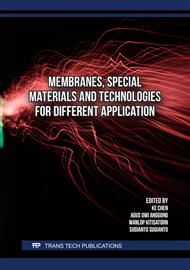[1]
K. Likhitwitayawuid, R. Rungserichai, N. Ruangrungsi, T. Phadungcharoen, Flavonoids from Ochna integerrima, Phytochemistry. 56 (2001) 353–357.
DOI: 10.1016/s0031-9422(00)00409-x
Google Scholar
[2]
T. Smitinand, K. Larsen, Flora of Thailand vol. 2, Tistr Press, Bangkok, 1981.
Google Scholar
[3]
Ichino, C., Kiyohara, H., Soonthornchareonnon, N., Chuakul, W., Ishiyama, A., Sekiguchi, H., Yamada, Antimalarial activity of biflavonoids from Ochna integerrima. Planta Med. 72 (2006) 611–614.
DOI: 10.1055/s-2006-931569
Google Scholar
[4]
A.K.R. Bandi, D.U. Lee, R.G. Tih, D. Gunasekar, B. Bodo, Phytochemical and biological studies of Ochna species. Chem. Biodivers. 9 (2012) 251–271.
DOI: 10.1002/cbdv.201100164
Google Scholar
[5]
V. Reutrakul, N. Ningnuek, M. Pohmakotr, C. Yoosook, C. Napaswad, J. Kasisit, T. Santisuk, P. Tuchinda, Anti HIV-1 flavonoid glycosides from Ochna integerrima. Planta Med. 73 (2007) 683–688.
DOI: 10.1055/s-2007-981538
Google Scholar
[6]
V. Buranasudja, K. Kobtrakul, S. Vimolmangkang, A. Binalee, K. Sanookpan, T.Y. Vu, K.L.V. Huynh, B. Le, H.T. Nguyen, K.M. Do, V.S. Dang, H.M. Nguyen, Some antioxidant properties of components from the flower of Ochna integerrima and their beneficial effects on HaCaT Keratinocytes and in silico analysis on tyrosinase. Chem. Biodivers. 19 (2022) e202100882.
DOI: 10.1002/cbdv.202100882
Google Scholar
[7]
N.C. Veitch, P.S. Sutton, G.C. Kite, H.E. Ireland, Six New Isoflavones and a 5-Deoxyflavonol Glycoside from the Leaves of Ateleia h erbertsmithii. J. Nat. Prod. 66 (2023) 210–216.
DOI: 10.1021/np020425u
Google Scholar
[8]
H.C. Jha, F. Zilliken, E. Breitmaier, Carbon-13 chemical shift assignments of chromones and isoflavones. Can. J. Chem. 58 (1980) 1211–1219.
DOI: 10.1139/v80-189
Google Scholar
[9]
K.R. Markham, B. Ternai, R. Stanley, H. Geiger, T.J. Mabry, Carbon-13 NMR studies of flavonoids—III: Naturally occurring flavonoid glycosides and their acylated derivatives. Tetrahedron. 34 (1978) 1389–1397.
DOI: 10.1016/0040-4020(78)88336-7
Google Scholar
[10]
T. Stalin, N. Rajendiran, A study on the spectroscopy and photophysics of 4-hydroxy-3-methoxybenzoic acid in different solvents, pH and β-cyclodextrin. J. Mol. Struct. 794 (2006) 35–45.
DOI: 10.1016/j.molstruc.2006.01.038
Google Scholar
[11]
T. Tukiran, F. Mahmudah, N. Hidayati, K. Shimizu, Gallic acid: A phenolic acid and its antioxidant activity from stem bark of chloroform extracts of Syzygium litorale (blume) amshoff (myrtaceae). Molekul. 11 (2016) 180–189.
DOI: 10.20884/1.jm.2016.11.2.215
Google Scholar
[12]
A. Joompang, N. Jangpromma, K. Choowongkomon, W. Payoungkiattikun, A. Tankrathok, J. Viyoch, K. Luangpraditkun, S. Klaynongsruang, Evaluation of tyrosinase inhibitory activity and mechanism of Leucrocin I and its modified peptides. J. Biosci. Bioeng. 130 (2020) 239–246.
DOI: 10.1016/j.jbiosc.2020.04.002
Google Scholar
[13]
I. Kubo, I. Kinst-Hori, Tyrosinase inhibitors from cumin. J. Agric. Food Chem. 46 (1998), 5338–5341.
DOI: 10.1021/jf980226+
Google Scholar
[14]
W. Yi, R. Cao, W. Peng, H. Wen, Q. Yan, B. Zhou, L. Ma, H. Song, Synthesis and biological evaluation of novel 4-hydroxybenzaldehyde derivatives as tyrosinase inhibitors. Eur. J. Med. Chem. 45 (2010) 639–646.
DOI: 10.1016/j.ejmech.2009.11.007
Google Scholar
[15]
D.E. Pegnyemb, R.G. Tih, B.L. Sondengam, A. Blond, B. Bodo, Flavonoids of Ochna afzelii. Phytochemistry. 64 (2003) 661–665.
DOI: 10.1016/s0031-9422(03)00267-x
Google Scholar
[16]
C. Moro, I. Palacios, M. Lozano, M. D'Arrigo, E. Guillamo´n, A. Villares, J.A. Martı´nez, A. Garcı´a-Lafuente, Antiinflammatory activity of methanolic extracts from edible mushrooms in LPS activated RAW 264.7 macrophages. Food Chem. 130 (2012) 350–355.
DOI: 10.1016/j.foodchem.2011.07.049
Google Scholar
[17]
C. Mouffouk, S. Mouffouk, K. Oulmi, S. Mouffouk, H. Haba, In vitro photoprotective, hemostatic, anti-inflammatory and antioxidant activities of the species Linaria scariosa Desf. S. Afr. J. Bot. 130 (2020) 383–388.
DOI: 10.1016/j.sajb.2020.01.003
Google Scholar
[18]
S.C. Pendota, A.R. Ndhlala, A.O. Aremu, M.A. Aderogba, J. Van Staden, Anti-inflammatory, antioxidant and in silico studies of Buddleja salviifolia (L). Lam leaf constituents. S. Afr. J. Bot. 93 (2014) 79–85.
DOI: 10.1016/j.sajb.2014.03.012
Google Scholar
[19]
D.K. Patel, Potential Benefits of Tricetin in Medicine for the Treatment of Cancers and Other Health-Related Disorders: Medicinal Importance and Therapeutic Benefit. Nat. Prod. J. 12 (2022) 12–19.
DOI: 10.2174/2210315512666211221113117
Google Scholar



